-
 Bitcoin
Bitcoin $105,953.9980
3.06% -
 Ethereum
Ethereum $2,445.3292
6.68% -
 Tether USDt
Tether USDt $1.0006
-0.03% -
 XRP
XRP $2.1968
7.03% -
 BNB
BNB $643.2903
2.13% -
 Solana
Solana $144.2799
3.82% -
 USDC
USDC $1.0000
-0.03% -
 TRON
TRON $0.2739
0.49% -
 Dogecoin
Dogecoin $0.1642
4.47% -
 Cardano
Cardano $0.5834
5.49% -
 Hyperliquid
Hyperliquid $38.0741
2.80% -
 Sui
Sui $2.7741
7.56% -
 Chainlink
Chainlink $13.4107
11.26% -
 Bitcoin Cash
Bitcoin Cash $450.4828
-0.61% -
 UNUS SED LEO
UNUS SED LEO $9.1301
0.64% -
 Stellar
Stellar $0.2476
5.49% -
 Avalanche
Avalanche $18.0637
5.09% -
 Toncoin
Toncoin $2.9066
2.43% -
 Shiba Inu
Shiba Inu $0.0...01160
4.01% -
 Hedera
Hedera $0.1527
8.00% -
 Litecoin
Litecoin $84.6122
2.37% -
 Monero
Monero $317.6076
5.76% -
 Ethena USDe
Ethena USDe $1.0008
0.02% -
 Polkadot
Polkadot $3.4519
5.27% -
 Dai
Dai $1.0000
-0.03% -
 Bitget Token
Bitget Token $4.2835
5.62% -
 Uniswap
Uniswap $7.0443
9.78% -
 Pepe
Pepe $0.0...09964
7.41% -
 Pi
Pi $0.5391
4.64% -
 Aave
Aave $264.1743
11.26%
Is the bottom three consecutive positives a reversal? Do I have to wait for confirmation of the pullback?
After three consecutive positive closes, traders should wait for a confirmed pullback, using volume, RSI, and support levels to validate a potential market reversal.
Jun 08, 2025 at 10:49 am
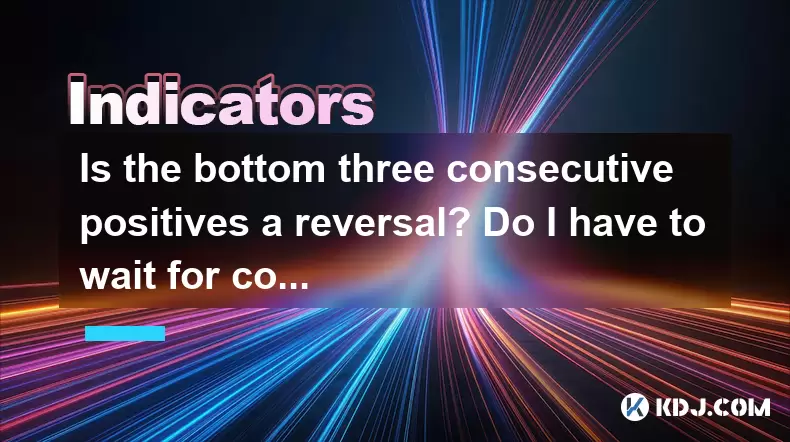
Understanding the Bottom Three Consecutive Positives
In the world of cryptocurrency trading, the concept of "bottom three consecutive positives" is often discussed as a potential indicator of a market reversal. This term refers to a situation where the price of a cryptocurrency experiences three consecutive positive daily closes after hitting a low point. Traders and analysts look for such patterns as they might signal the end of a downtrend and the beginning of an uptrend. However, it's crucial to understand that this pattern alone is not a definitive indicator of a reversal and should be used in conjunction with other technical analysis tools.
The Mechanics of Three Consecutive Positives
When a cryptocurrency's price reaches a low point and then records three consecutive days of positive closes, it suggests that the selling pressure may be diminishing. The three consecutive positives can be observed on a daily chart, where each candlestick represents a day's worth of trading activity. For this pattern to be considered, the closing price of each day must be higher than the previous day's closing price. This sequence can be a sign that the market sentiment is shifting from bearish to bullish, but it requires further confirmation to be considered a reliable reversal signal.
The Need for Confirmation of the Pullback
While the three consecutive positives may hint at a potential reversal, it's essential to wait for a confirmation of the pullback before making any trading decisions. A pullback is a temporary decline in prices following a period of upward movement. Confirmation of the pullback can be established through various methods, including:
- Volume analysis: An increase in trading volume during the pullback can indicate strong interest and support for the new upward trend.
- Technical indicators: Tools like the Relative Strength Index (RSI) and Moving Averages can help confirm whether the pullback is a healthy correction within an uptrend or a sign of a failed reversal.
- Price action: A successful pullback should see the price holding above the previous low, indicating that the bulls are in control and the downtrend has indeed reversed.
Analyzing the Pullback for Confirmation
To effectively analyze the pullback for confirmation, traders should pay close attention to the following steps:
- Monitor the price movement: After the three consecutive positives, watch how the price reacts. If it pulls back but stays above the recent low, it could be a sign of a confirmed reversal.
- Use technical indicators: Employ indicators such as the RSI to gauge the strength of the pullback. An RSI that remains above 30 during the pullback suggests that the market is not oversold and the uptrend may continue.
- Check for volume: A pullback accompanied by high trading volume can indicate strong buying interest, reinforcing the possibility of a reversal.
- Observe support levels: If the price finds support at a known level during the pullback, it further validates the potential for a sustained upward move.
Practical Example of Waiting for Confirmation
Let's consider a practical example to illustrate the importance of waiting for confirmation after observing three consecutive positives. Suppose Bitcoin (BTC) hits a low of $20,000 and then closes at $20,500, $21,000, and $21,500 over the next three days. This sequence would constitute three consecutive positives. However, before jumping into a long position, a trader should wait for a pullback to confirm the reversal.
- Price movement: After reaching $21,500, BTC pulls back to $21,000 but holds above the $20,000 low.
- Technical indicators: The RSI stays above 30 during the pullback, indicating that the market is not oversold.
- Volume: The pullback is accompanied by high trading volume, suggesting strong buying interest.
- Support levels: The price finds support at the $21,000 level, which was a previous resistance turned support.
In this scenario, the confirmation of the pullback supports the notion that the three consecutive positives were indeed a sign of a reversal. However, without this confirmation, the trader would be risking entering a trade prematurely.
The Role of Other Technical Indicators
While the three consecutive positives can be a useful initial signal, relying solely on this pattern is risky. Traders should incorporate other technical indicators to increase the reliability of their analysis. Some of these indicators include:
- Moving Averages: A crossover of short-term moving averages above long-term moving averages can confirm an uptrend.
- MACD (Moving Average Convergence Divergence): A bullish crossover of the MACD line above the signal line can support the reversal signal.
- Fibonacci Retracement Levels: If the pullback respects key Fibonacci levels, it can add credibility to the reversal.
The Importance of Risk Management
Even with a confirmed reversal, it's crucial to implement sound risk management strategies. Traders should set stop-loss orders to limit potential losses if the market moves against their position. Additionally, they should determine their risk-reward ratio before entering a trade, ensuring that the potential reward justifies the risk taken.
Frequently Asked Questions
Q: How long should I wait for confirmation after seeing three consecutive positives?
A: The duration can vary depending on the specific market conditions and the cryptocurrency in question. Generally, traders might wait for a few days to a week to observe the price action and confirm the pullback. It's important to be patient and not rush into a trade based solely on the initial pattern.
Q: Can the three consecutive positives be observed on different time frames other than daily?
A: Yes, the three consecutive positives can be applied to different time frames, such as hourly or weekly charts. However, the significance and reliability of the pattern may vary depending on the chosen time frame. Shorter time frames may be more susceptible to false signals, while longer time frames might provide more reliable indications of a reversal.
Q: Are there any specific cryptocurrencies where the three consecutive positives are more reliable?
A: The reliability of the three consecutive positives does not depend on the specific cryptocurrency but rather on the overall market conditions and the volume of trading activity. However, major cryptocurrencies like Bitcoin and Ethereum tend to have more reliable signals due to their higher liquidity and trading volumes.
Q: How can I differentiate between a genuine reversal and a temporary bounce after three consecutive positives?
A: Differentiating between a genuine reversal and a temporary bounce requires careful analysis of additional factors such as volume, technical indicators, and the overall market trend. A genuine reversal is often accompanied by increasing volume, positive signals from technical indicators, and a sustained upward movement. In contrast, a temporary bounce might lack strong volume support and fail to break through key resistance levels.
Disclaimer:info@kdj.com
The information provided is not trading advice. kdj.com does not assume any responsibility for any investments made based on the information provided in this article. Cryptocurrencies are highly volatile and it is highly recommended that you invest with caution after thorough research!
If you believe that the content used on this website infringes your copyright, please contact us immediately (info@kdj.com) and we will delete it promptly.
- Cryptocurrencies: Chart-Breaking Buys Beyond the Hype
- 2025-06-25 04:45:12
- Navigating Crypto Volatility: UNI Price, SUI Token, and the Rise of Unstaked
- 2025-06-25 04:45:12
- Bitcoin, Ethereum, and Geopolitical Tensions: Navigating the Iran-Israel Ceasefire
- 2025-06-25 05:05:13
- JPMorgan, Blockchain, and JPMD Token: A Quantum Leap for On-Chain Finance?
- 2025-06-25 05:05:13
- Bitcoin Desktop Wallets in 2025: A New Yorker's Take
- 2025-06-25 04:25:13
- Coinbase Stock Jumps: Decoding the Reasons Behind the Surge
- 2025-06-25 04:25:13
Related knowledge
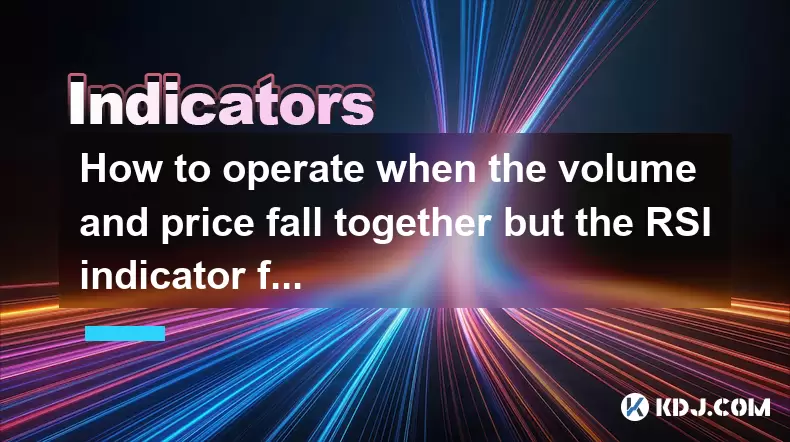
How to operate when the volume and price fall together but the RSI indicator forms a bottom divergence?
Jun 25,2025 at 04:29am
Understanding the Concept of RSI Bottom DivergenceWhen analyzing cryptocurrency price charts, traders often rely on technical indicators to spot potential reversals. One such signal is a bottom divergence in the Relative Strength Index (RSI). This occurs when the price makes a new low, but the RSI does not confirm that low and instead forms a higher low...
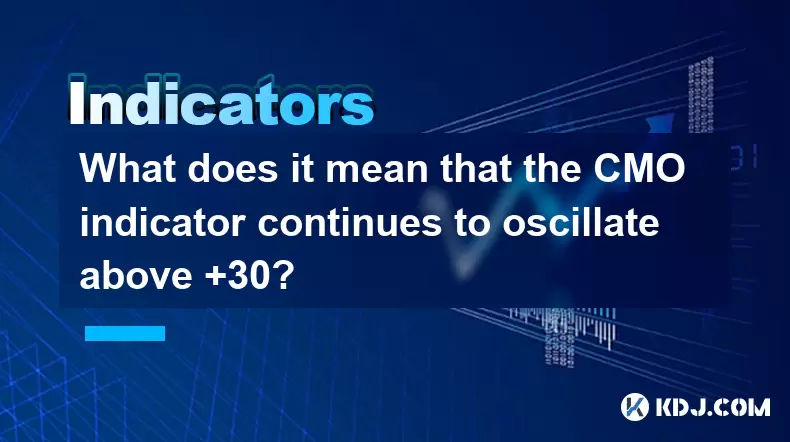
What does it mean that the CMO indicator continues to oscillate above +30?
Jun 25,2025 at 03:29am
Understanding the CMO IndicatorThe Chande Momentum Oscillator (CMO) is a technical analysis tool developed by Tushar Chande to measure momentum in financial markets. In cryptocurrency trading, the CMO helps traders identify overbought or oversold conditions and potential trend reversals. The oscillator ranges from -100 to +100, with values above zero in...

What does it mean that the ATR indicator suddenly doubles after hitting a new low this year?
Jun 24,2025 at 11:57pm
Understanding the ATR IndicatorThe Average True Range (ATR) is a technical analysis indicator used to measure market volatility. Developed by J. Welles Wilder, ATR calculates the average price range between a security’s high and low over a specific period—typically 14 periods. It does not indicate the direction of price movement but rather how volatile ...
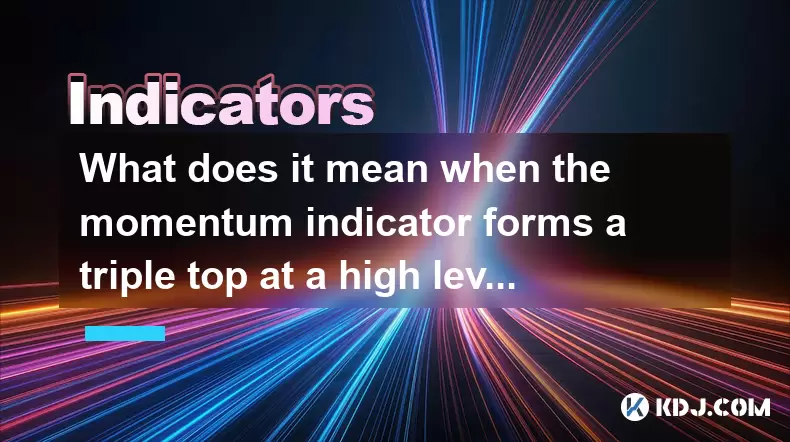
What does it mean when the momentum indicator forms a triple top at a high level?
Jun 25,2025 at 03:15am
Understanding the Momentum Indicator in Cryptocurrency TradingThe momentum indicator is a widely used technical analysis tool that measures the rate of change in price movements over a specified period. In cryptocurrency trading, where volatility is high and trends can reverse rapidly, this indicator helps traders identify potential trend reversals or c...
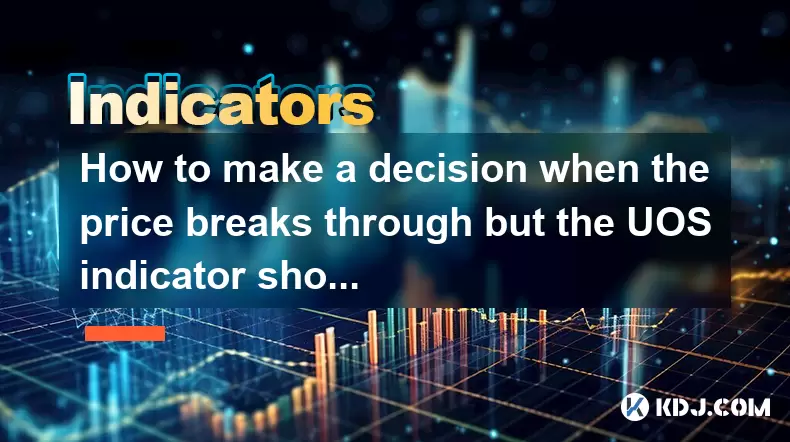
How to make a decision when the price breaks through but the UOS indicator shows a top divergence?
Jun 24,2025 at 11:42pm
Understanding the UOS Indicator and Price BreakthroughsThe Ultimate Oscillator (UOS) is a momentum oscillator that combines multiple timeframes to provide a more accurate picture of market momentum. When traders observe a price breakthrough — where the price moves above a key resistance level — but the UOS indicator shows a top divergence, it creates a ...

How to interpret the stochastic indicator being blunted for 5 consecutive days in the overbought area?
Jun 25,2025 at 03:00am
Understanding the Stochastic Indicator in Cryptocurrency TradingThe stochastic indicator is a momentum oscillator widely used in technical analysis within the cryptocurrency market. It helps traders identify overbought and oversold conditions by comparing a particular closing price of an asset to a range of its prices over a certain period. The standard...

How to operate when the volume and price fall together but the RSI indicator forms a bottom divergence?
Jun 25,2025 at 04:29am
Understanding the Concept of RSI Bottom DivergenceWhen analyzing cryptocurrency price charts, traders often rely on technical indicators to spot potential reversals. One such signal is a bottom divergence in the Relative Strength Index (RSI). This occurs when the price makes a new low, but the RSI does not confirm that low and instead forms a higher low...

What does it mean that the CMO indicator continues to oscillate above +30?
Jun 25,2025 at 03:29am
Understanding the CMO IndicatorThe Chande Momentum Oscillator (CMO) is a technical analysis tool developed by Tushar Chande to measure momentum in financial markets. In cryptocurrency trading, the CMO helps traders identify overbought or oversold conditions and potential trend reversals. The oscillator ranges from -100 to +100, with values above zero in...

What does it mean that the ATR indicator suddenly doubles after hitting a new low this year?
Jun 24,2025 at 11:57pm
Understanding the ATR IndicatorThe Average True Range (ATR) is a technical analysis indicator used to measure market volatility. Developed by J. Welles Wilder, ATR calculates the average price range between a security’s high and low over a specific period—typically 14 periods. It does not indicate the direction of price movement but rather how volatile ...

What does it mean when the momentum indicator forms a triple top at a high level?
Jun 25,2025 at 03:15am
Understanding the Momentum Indicator in Cryptocurrency TradingThe momentum indicator is a widely used technical analysis tool that measures the rate of change in price movements over a specified period. In cryptocurrency trading, where volatility is high and trends can reverse rapidly, this indicator helps traders identify potential trend reversals or c...

How to make a decision when the price breaks through but the UOS indicator shows a top divergence?
Jun 24,2025 at 11:42pm
Understanding the UOS Indicator and Price BreakthroughsThe Ultimate Oscillator (UOS) is a momentum oscillator that combines multiple timeframes to provide a more accurate picture of market momentum. When traders observe a price breakthrough — where the price moves above a key resistance level — but the UOS indicator shows a top divergence, it creates a ...

How to interpret the stochastic indicator being blunted for 5 consecutive days in the overbought area?
Jun 25,2025 at 03:00am
Understanding the Stochastic Indicator in Cryptocurrency TradingThe stochastic indicator is a momentum oscillator widely used in technical analysis within the cryptocurrency market. It helps traders identify overbought and oversold conditions by comparing a particular closing price of an asset to a range of its prices over a certain period. The standard...
See all articles
























































































